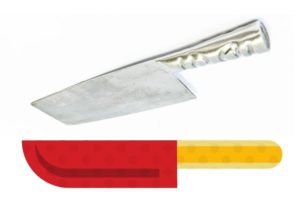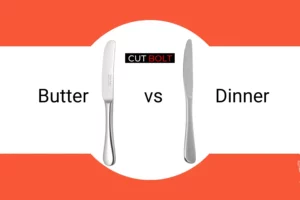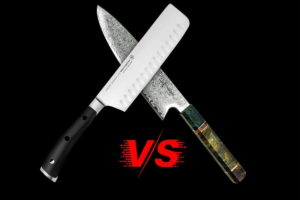Japanese kitchen knives are some of the best on the market for cutting and slicing. If you are a professional chef or a cooking enthusiast, the following information will help you to know about types of Japanese kitchen knives and choose the one that best suits your needs.
Generally speaking, the main differences between Japanese knives involves the materials used in construction and the specialized designs for specific purposes.
There are other considerations: handle shape, single or double beveled edges, and finishes are also important. Which will determine if you are a fit for culinary skills and practices. Once you understand the differences, you’ll be ready to find the best one for you.

TYPES OF JAPANESE KITCHEN KNIVES
European kitchen knives are multi-purpose masterpieces and culinary workhorses. They are used for everything from the hard work of cutting up a chicken to more delicate tasks like chopping herbs, and everything in between. It’s the Clydesdale of kitchen knives, plowing through all manner of tasks.
Japanese chef’s knives are delicate, somewhat counterintuitive due to the hardness of the steel, and have specialized applications. As such, there are four different styles that could be considered chef’s knives, some for general use, others that excel at different tasks.
Also Read: 5 Easy steps to remove rust from knife
GYUTO (EQUIVALENT TO CHEF’S KNIFE)
In general, the Gyuto knife has several features in common with a Western-style chef’s knife.
This knife has evolved to perform multiple tasks: slicing vegetables, fish and meat. As such, it has a long, thin blade.
The blade profile is quite similar to that of a French sabatier, although the curve of the belly of the cutting edge is less pronounced. Depending on the blade profile, it can be cut with some Gyutos, most are designed for push cutting.

The edge profile gives you more contact with a cutting board, providing a larger cutting surface. It doesn’t need to be lifted as high, resulting in less fatigue and more efficient cutting.
The tip is often slightly lower, mostly in line with the center of gravity. This makes it very good for detailed work and decorative cut presentations.
It has a double beveled edge, is tapered on both sides, and is usually between 8 and 12 inches. With an ergonomically shaped handle or in the traditional “wa” shape – straight, with a round or octagonal profile and usually made of hardwood.
The gyuto is a lightweight, multi-purpose knife that excels at precision work such as mincing, fine vegetable preparation, and light proteins. However, this type does not work well when cutting through dense materials like bone, gristle, or slicing large foods like Hubbard squash.
THE SANTOKU
The Santoku is another general-purpose kitchen knife similar in appearance to a chef’s knife: shorter, slimmer, and more agile, combining the characteristics of a Gyuto and a Nakiri.
It measures between 5 and 7 inches, and has a flat edge and a sheep’s foot tip, with a dramatic angular point of up to 60 degrees.
With a slight angle on the cutting edge, it allows some rock to be cut, but there is very little tip travel due to the sheep’s-foot profile – pushing cutting straight up and down is easier and more efficient.
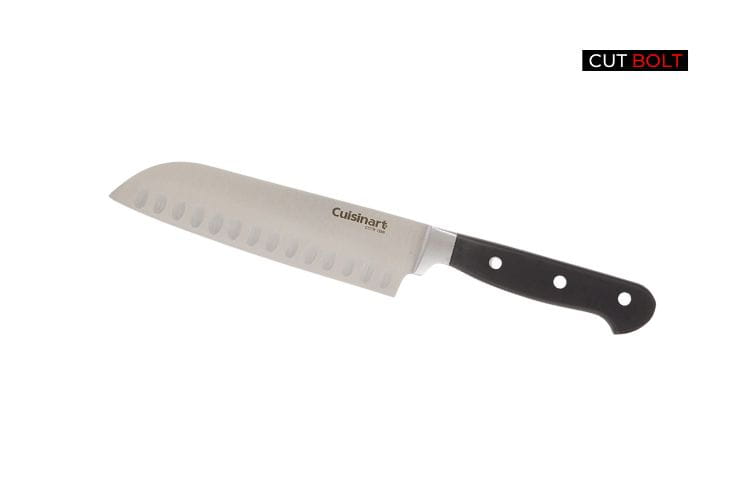
A typical santoku will have a Western-style double-beveled edge, and maintain a uniform thickness from the spine to the edge. The blade can be flat or incorporate granton dividers for better food release.
The shape of the point, plus the height of the blade, make a santoku great for scooping up food, and provides a solid, secure foothold for your hand when chopping.
Like a chef’s knife, the santoku can be used for a variety of cutting jobs in the kitchen. Light, nimble and easy to maneuver, it’s great for chopping and slicing, but doesn’t have the blade length for jobs like chopping fish or meat.
A knife needs regular care, learn how to take care of a knife.
THE SUJIHIKI (CUTTER)
The sujihiki has a long, narrow blade with a short height that is designed for cutting boneless meat, fish, and poultry.
The short height means less surface area, which reduces friction, making it ideal for cutting thin slices of your favorite protein. Even fatty or oily fish will not stick to the surface.
A long, thin blade, usually in the 9.5- to 12-inch range, helps slide and cut through large chunks of protein without the need for a sawing motion.
The cutting action is a simple clean precise cutting drag with no torn pieces, requires a skillful cutting technique.
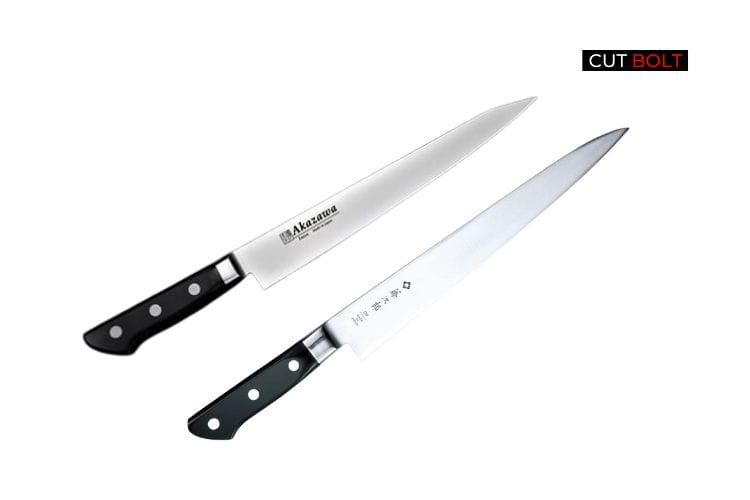
Often considered the Western version of the traditional sushi/sashimi knife (the yanagi), the sujihiki knife is similar in size and function to a conventional carving knife, ideal for slicing and portioning.
The suji is usually lighter and more flexible than the yanagi, making it useful for cutting and slicing work.
Another noticeable difference between sujihiki and yanagi is the shape of the rim. A yanagi will have a single bevel, while the sujihiki has a double bevel.
Some manufacturers produce sujihikis with serrations, granton divots, or a hammered profile on the cutting edge to further reduce friction and prevent sticking. Often aesthetic in nature, the overall design is usually effective enough to cut cleanly without the add-ons.
THE NAKIRI (TRADITIONAL)
The nakiri is a traditional vegetable knife designed to deliver full, rhythmic strokes.
Similar in shape to a short blade, it has a flat profile characterized by a thin, straight blade – although some may have a slight curve towards the edge. The column tapers to a square, blunt point, but is thin behind the rim with a symmetrical, convex taper.
Created for the primary purpose of slicing, dicing, and chopping vegetables, the blade length is usually between 5 and 7 inches, which is ample length for most vegetables.
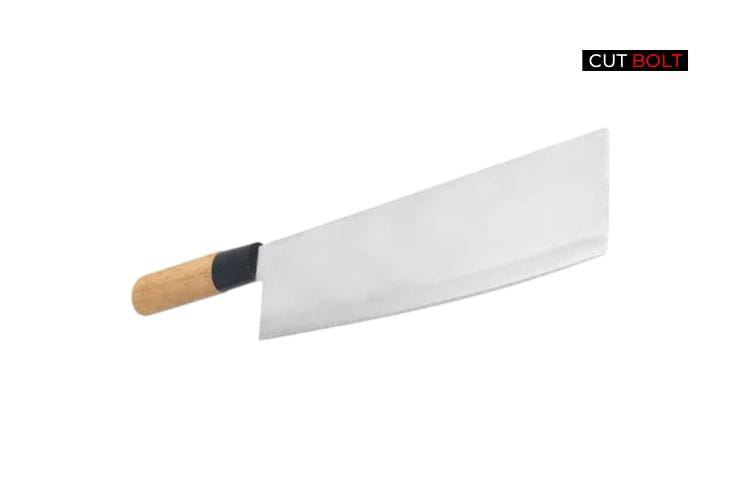
With a double beveled edge, food falls off easily as the blade glides across what you’re preparing, and the square tip makes it one of the safest blades to use in the kitchen.
Due to the flat edge, a rolling motion is almost impossible. Instead, nakiri uses a straight up-and-down motion, without the need to push or pull horizontally. You can make paper-thin slices and ribbon cuts as the edge travels across the food to the surface with clean, even cuts.
Due to the fine, refined cutting edge, they are excellent for use on delicate vegetables and herbs without bruising or crushing delicate tissue. The nakiri is more used by home cooks.
THE CHUKABOCHO (KNIFE)
The Japanese version of a Chinese knife is called a chukabocho. It is a multi-purpose cutter, each part of the blade can be used for the preparation of fruits, vegetables, herbs and spices.
These large blades are not intended for preparing bone-in meats…
Large and rectangular in shape, the blade length is around 7 to 8 inches with a height of 4 to 5 inches.
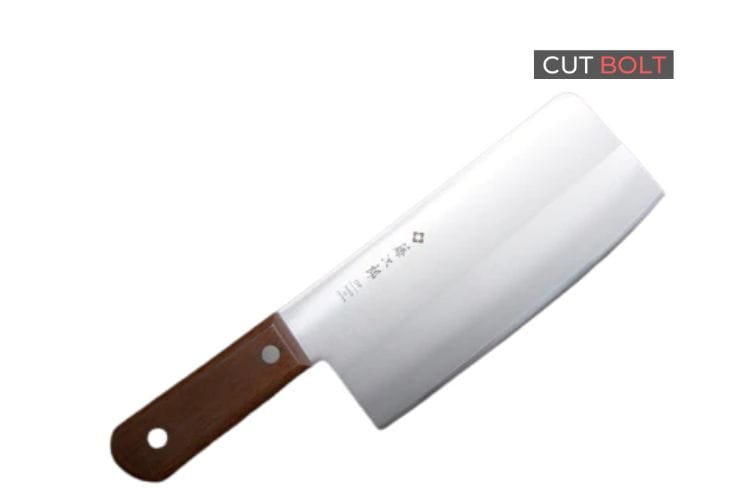
The end is blunt and square with a thick spine that tapers to a fine edge with a double bevel for versatile performance. The cutting edge is generally straight, but may have a slight curve to the tip.
Agile, almost all cutting and slicing techniques work with a chukabocho, as long as the edge has a curve for the cut.
Effective at cutting down large vegetables like a cabbage, the blade’s thinness also makes it adept at delicate tasks like chopping herbs, and slicing and peeling as well.
Use the flat of the blade to crush items like ginger, garlic, or shelled nuts, or the tang to tenderize boneless meat. And of course, the large surface area of the blade makes it the best tool for picking up and moving mountains of food.
THE DEBA
Like the western bast, the traditional bast is also thick and robust, but has the main application of butchering and filleting fish.
The blade length of a deba is usually between 6.5 and 8 inches, although there are some as small as 4 inches in length.
The height of the blade is about 1.5 to 2 inches, and the edge is ground to a sharp angle in a single bevel, with a flat back.
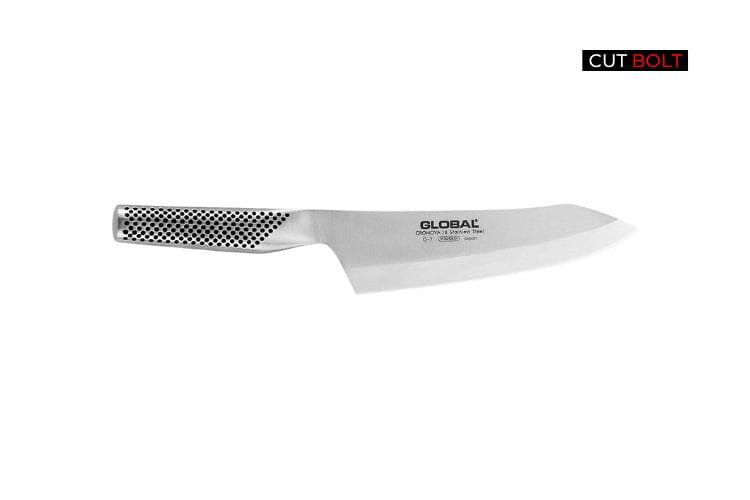
Excellent for cutting the soft meat of fish as well as fish bones, some chefs use them for poultry and for cutting vegetables. The bevel can help those who are not familiar with the proper technique.
Completely different from a flexible Western fillet knife, the “deba” is sturdy and heavy. A different skill is required to use it without crushing the meat.
THE FUNAYUKI
The funayuki was originally used on fishing boats, primarily as a light fillet knife to check the quality of the catch, to clean and fillet fish, and to do meal preparation.
Smaller and shorter than a yanagiba (the blade of choice for preparing sashimi and other types of sushi, and for cutting raw fish and shellfish), it has a delicate, fine blade that requires a deft hand to use without chipping the edge.
Blade measurements range from 5.5 to 8.5 inches, and can be up to 2 inches from heel to spine.

The cutting edge can be single or double beveled, fairly flat with minimal belly, and a very thin cross section, making it good for delicate and precise tasks.
A jack of all trades, the smaller funayukis are often used as paring and trimming knives, as well as for fish preparation and filleting.
A practical multi-tasking knife, it can be a bit of a princess due to its ultra thin and brittle blade.
THE HANKOTSU
The hankotsu is a small, hard knife used for light meats. It is ideal for tasks such as boning, trimming meat, getting between bones, breaking down poultry.
These have a sharp, pointed tip that can be inserted into a cut and glided along the bone, connective tissue, or fat. The hankotsu also has a short height, about 1 to 1.5 inches, which makes the blade nimble enough to be easily turned and maneuvered while cutting.
A unique feature of hankotsu is the cutting edge near the heel area, which actually has no heel.
Depending on the brand, between a quarter and a third of the length of the edge at the heel end remains unsharpened. This provides a strong edge for any scraping that needs to be done, and offers finger protection from slippage.
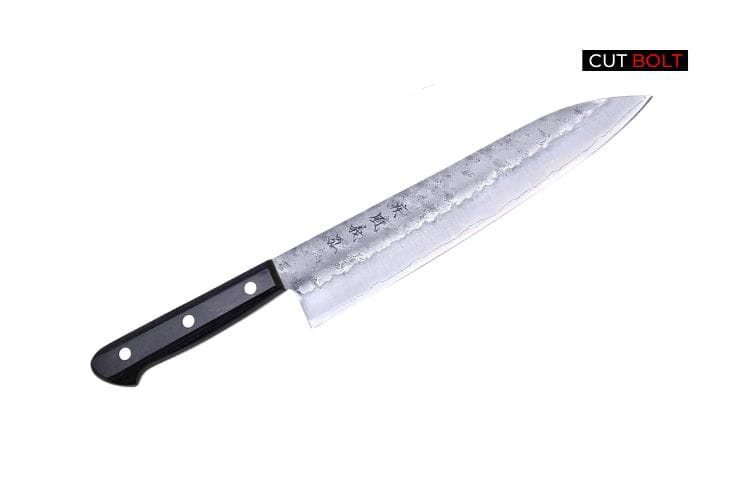
Keep in mind that without a heel, there is also no toe protection.
The blade length is usually around 6 inches, and the edge is technically double beveled – but it is sharpened at an asymmetrical angle, in a ratio of around 90/10 to the right hand side.
If you are left-handed, this may not be the best option. It’s going to be awkward for vertical boning, unless you order a special left-handed one.
Hankotsus also require special care when sharpening and polishing. All the sharpening action takes place at the major angle, or right edge, while the minor angle is only touched to remove burrs.
The hankotsu has a thick spine and muscular cross-section, and you’ll find that they don’t have the same flex as Western-style boning knives.
Ruggedly built, they often have a sturdy handle to provide a secure grip and maximum control.
THE HONESUKI
The Honesuki is another boning knife, but this one is designed for the specific task of breaking up poultry and cutting the joints – but not for cutting bones.
With a distinctive triangular profile running from heel to toe, the blade is fairly stiff with little flex, and a perfectly straight cutting edge. Blade length ranges from 5.5 to 8 inches, measuring about 1.5 inches from heel to spine.
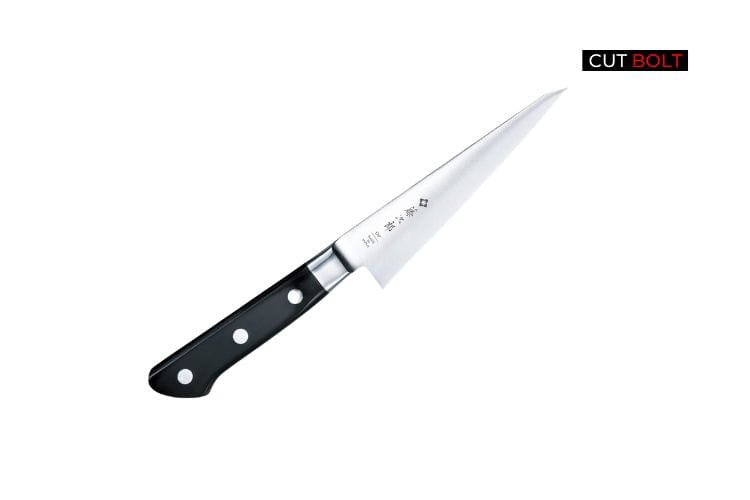
Like hankotsu, traditional honesukis have an asymmetrical bottom edge on the right side. But more recently, honesukis with a 50/50 equal bevel on both sides have become available, making these models a good choice for left-handed users.
Due to the compact size of this knife, it is also useful as a utility knife.
THE KIRITSUKE
The kiritsuke is a hybrid knife designed to function as both a fish cutter and a vegetable knife. Long and slender, it has a sword-like appearance with a sheepsfoot tip, and is one of the few multipurpose blades used in Japanese cooking.
Traditional styles have a blade length of 10 to 12 inches with a single beveled edge, and are relatively short in height, about 1.5 to 2 inches. The profile has a straight edge, and some have a touch of lift toward the tip.
Western versions are often double-beveled, with blades as short as 6 inches.
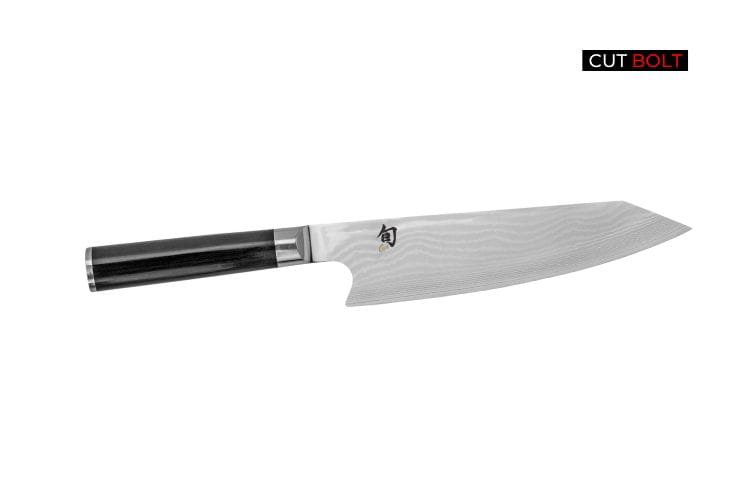
Kiritsukes are best used for slicing and pushing cuts. These work well with vegetables, raw fish, and cooked proteins.
The tip is quite nimble for tap cutting, and the long blade is exquisite for thinly slicing vegetables or cutting them into a nice julienne or brunoise.
They’re also a good choice for cleaning and dividing fish, or thinly slicing protein for an elegant presentation.
Apprentices unfamiliar with single bevel performance often find traditional versions difficult to use, with shimming and twisting being common complaints. But the double bevel version gives you more versatility for those with less than master cutting skills.
THE YANAGIBA
The yanagiba is a sashimi knife, traditionally used to cut and portion boneless fish, shellfish, sushi, and sashimi.
Sashimi knives, long, thin and thin, are elegant tools designed to cut in a single drag stroke that creates clean, sharp edges using only the weight of the knife, and the longer the blade, the better the results.

The length of the blades varies between 8 and 12 inches, with a short height of about 1.5 inches. The edge is ground to a single bevel for greater sharpness, and to a sharp, pointed tip. A sharp hollow on the back helps to release the pieces after cutting them.
The bezel is typically ground on the right side, but left-handed versions are available through special order.
Traditionally used by sushi chefs, this elegant blade is gaining popularity with Western cooks for use as a carving knife.
These are the main types of Japanese kitchen knives that are used frequently by cooks around the world.
FEATURES TO CONSIDER – HOW TO BUY A JAPANESE KNIFE
HARDNESS
One of the most significant differences when comparing Japanese knives to Western ones is the high carbon content and the quality of the steel used, resulting in a very hard steel.
Why is this significant? Harder steel can be sharpened to a sharper angle, which makes the cut more effective – typically around 15-20° for Japanese knives, and 20-30° for Western ones.
Hard steel will also hold a sharp edge longer, so they won’t require sharpening or honing as often. The cross section of the blade can be made thinner, which reduces weight and improves usability.
The industry standard for measuring hardness is the Rockwell Scale. The higher the number, the harder the steel. An increase of one degree on the scale represents a ten percent increase in hardness.
It is common for a chef’s knife of European origin to range between 52-56 HRC, or the Rockwell hardness based on the C scale. This number is determined based on scales ranging from A to G, with B and C being the most used. This measurement can be as high as 58 for the Euro version, depending on the brand and quality.
By comparison, Japanese blades rarely measure less than 60 HRC, often as high as 64 – a dramatic difference.
TYPES OF STEEL
Although it is certainly an advantage, there are some disadvantages to metals that measure higher on the Rockwell scale. Extreme hardness is often combined with brittleness. This means that the edges of Japanese blades have a tendency to chip or break when used against dense materials, such as bone or hard gourds.
Tempering will reduce the hardness of the steel and make it tougher against chipping, but this comes at the cost of much prized sharpness.
STAINLESS STEEL VS. CARBON STEEL
To help counteract the brittleness of hard steel while retaining the corrosion- and stain-resistant qualities of stainless steel, Japanese knife makers have formulated many specialized, high-performance steel alloys.
These formulations will improve specific characteristics of the final product, such as sharpness and durability.
High-quality steel alloys in Japanese kitchen knives:
- Chromium (Cr) – is the main addition to stainless steel that improves stain resistance.
- Cobalt (Co) – increases strength and hardness, and binds the characteristics of individual elements in complex steels. And, it also allows quenching at higher temperatures for a harder product, with a higher HRC rating.
- Copper (Cu) – will increase corrosion resistance, and is used as a brazing agent in composite sheets.
- Molybdenum (Mo) – increases strength and hardness as well as toughness due to its hardening properties. It also improves corrosion resistance and machinability.
- Nickel (Ni) – adds strength and hardness.
- Vanadium (Va) – increases strength and hardness, as well as improves wear resistance, and makes sharpening easier.
- Tungsten (W) – adds strength and toughness, and also improves hardening properties.
When shopping for stainless and stain-resistant knives, look for names like VG-10, VG-Max, Molybdenum, inox, and SG2. They all represent a form of stainless.
And for professionals and serious users whose primary concern is sharpness, Japanese knives are also built the traditional way, with purer forms of carbon steel.
The Gyuto knife is made of “blue” carbon steel, it shows patina or controlled oxidation. This oxidation forms when the food reacts with the metal. Eventually, enough forms that the leaf becomes (mostly) nonreactive. It is not usually recommended. Stainless steel has come so far that carbon steel has few advantages left.
They provide exceptional toughness and performance, but have the tinting properties of carbon, with an even more brittle nature.
- White Steel – has the highest levels of purity, and is known for its superb sharpness and ease of resharpening.
- Blue Steel – has similar carbon levels as white steel, but has additional elements like tungsten and molybdenum for better edge retention and durability.
- Powdered steel – comes with a rich chemical composition with the addition of chromium, vanadium, and molybdenum. It offers a very hard cutting edge, superior performance and good rust resistance.
It is believed that steel will be the best choice for most people, both professional chefs and home cooks.
BLADE CONSTRUCTION AND FINISHES
While Eastern knives are forged using the same hot forging, stamping, and stock removal techniques as their Western counterparts, manufacturers aren’t shy about using processes that create laminated, coated, or composite blades.
COATING
Many traditional Japanese style knives have a hard core of high carbon steel which is then covered with layers of one or more steels.
The outer layers are typically of a more ductile material that protects the inner core, and the combination results in a final product that combines an extremely sharp edge with easy sharpening.
LAMINATE
This is a forging process where a hard carbon steel is wrapped with two layers of stainless steel, which are then forged together under extreme pressure and high heat.
Like the cladding, the laminate of a stainless steel exterior reinforces the hard core. It also adds stain resistant properties, which reduces maintenance. The result is a very sharp cutting edge that will hold its edge longer, and is much easier to resharpen.
COMPOUNDS
A composite blade is constructed from two different steel alloys, which are then joined by welding.
Welding is a four-step process that permanently bonds tool steel with a carbide such as tungsten, and a brazing agent such as copper. This allows the fabricator to use a high quality, high carbon steel for the core, for an excellent cutting edge, without the expense of using it for the entire blade.
It also results in a unique, decorative wavy line of copper behind the edge, which is revealed in the sharpening process.
DESIGN
Along with the greater diversity of design features, some of the knives described above also offer impressive aesthetic flair.
Processes like hand hammering, the flowing grain of Damascus coating, graffiti etching to designate the maker, and the wave pattern of composite blade technology turn these common cookwares into works of art.
And the distinctive beauty of these features elevate them into a world-class league – often with world-class prices to match.
DAMASCUS STEEL
You’ll often see Japanese knives made with Damascus steel, which features beautiful wavy patterns reminiscent of wet silk.
A damask pattern on the siding can make an eye-catching presentation.
Traditional Damascus is a crucible steel, composed of at least two different high carbon steels with similar hardening and tempering properties that are forged together.
When heated, the intermingled metals absorb carbon from the hot coal and produce a visibly crystalline structure. As the billet is forged and shaped, the crystals form the familiar wavy or water-like patterns.
Classic, high-intensity Damascus steel requires constant temperatures and a lot of skill to create a product that has plastic properties while being very hard.
Today, most Damascus-labeled knives are produced by wrapping an engraved coating around a hard steel core, leaving the cutting edge exposed. Much faster to manufacture, watermarks are created by the etching process.
Care must be taken when sharpening a Damascus blade, as the coating can easily scratch. To prevent damage to the wave pattern, it is common practice to apply thick layers of tape over the liner area while sharpening.
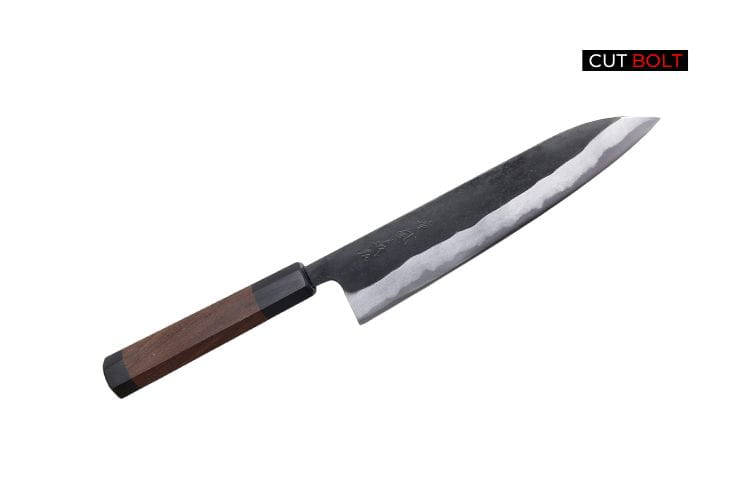
KUROUCHI FINISH JAPANESE KNIFE
A kurouchi finish has an old world look that gives a knife great character.
Also known as a blacksmith’s finish, kurouchi is a residue left over from forging. It has a somewhat flaky appearance which reduces reactivity in high carbon sheets.
Each sheet will vary in appearance, and leaving this finish in place also reduces production costs. This is because the final polishing step is eliminated, making these knives a more affordable option.
Some believe that the rough, unpolished finish also provides increased food release. Appreciated by many knife connoisseurs, the kurouchi finish lends a rustic aesthetic that adds charm to any knife collection.
HAMMERED JAPANESE KNIFE
A hammered finish, or tsuchime in Japanese, adds a lovely handcrafted aesthetic to a knife blade – hammered finish.
This Gyuto is from a small manufacturer and features an unusual pattern on its hammered finish. What may appear to be scratches are actually the blacksmith’s signature in Kanji.
But it also has a functional purpose. Each small divider created by hand hammering creates a small pocket of air, which reduces drag and provides quick food release on the blade.
This Yoshirhiro VG10 Stainless Gyuto has a hammered finish on the top of the blade as well as a Damascus coating on the bottom.
The tsuchime effect is created with a smooth faced hammer, like the round end of a pear ball, after which it is given a final polish to remove any high spots.
Final Words – TYPES OF JAPANESE KITCHEN KNIVES
Japan has a rich traditional history of knife making. Having the right knife in your kitchen is critical for efficient food preparation. After understanding the main differences between Japanese knives, you’ll be able to choose the one that’s right for your needs.
Thanks for reading, and I hope to hear from you in the comments below!
Related: Dinner knife vs Butter knife

